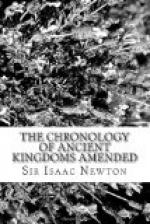Syncellus tells us, that the five days were added to the old year by the last King of the Shepherds: and the difference in time between the Reign of this King, and that of Ammon, is but small; for the Reign of the Shepherds ended but one Generation, or two, before Ammon began to add those days. But the Shepherds minded not Arts and Sciences.
The first month of the Luni-solar year, by reason of the Intercalary month, began sometimes a week or a fortnight before the Equinox or Solstice, and sometimes as much after it. And this year gave occasion to the first Astronomers, who formed the Asterisms, to place the Equinoxes and Solstices in the middles of the Constellations of Aries, Cancer, Chelae, and Capricorn. Achilles Tatius [69] tells us, that some antiently placed the Solstice in the beginning of Cancer_, others in the eighth degree of Cancer, others about the twelfth degree, and others about the fifteenth degree thereof._ This variety of opinions proceeded from the precession of the Equinox, then not known to the Greeks. When the Sphere was first formed, the Solstice was in the fifteenth degree or middle of the Constellation of Cancer: then it came into the twelfth, eighth, fourth, and first degree successively. Eudoxus, who flourished about sixty years after Meton, and an hundred years before Aratus, in describing the Sphere of the Ancients, placed the Solstices and Equinoxes in the middles of the Constellations of Aries, Cancer, Chelae, and Capricorn, as is affirmed by [70] Hipparchus Bithynus; and appears also by the Description of the Equinoctial and Tropical Circles in Aratus, [71] who copied after Eudoxus; and by the positions of the Colures of the Equinoxes and Solstices, which in the Sphere of Eudoxus, described by Hipparchus, went through the middles of those Constellations.




